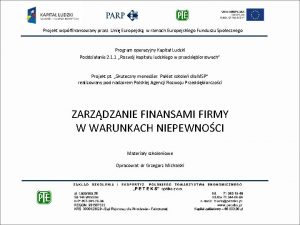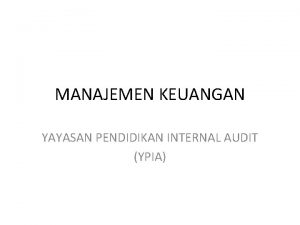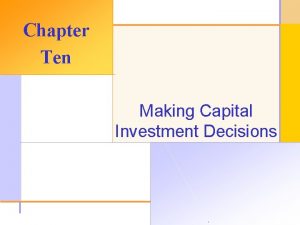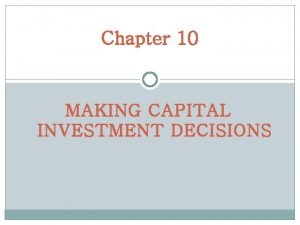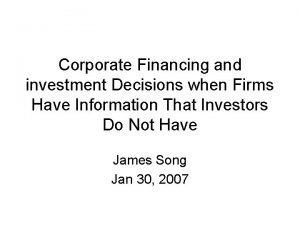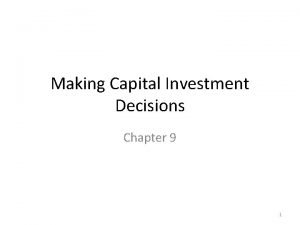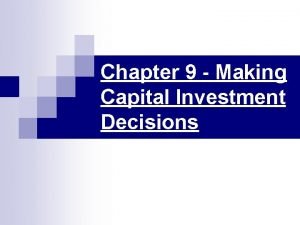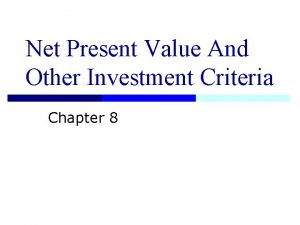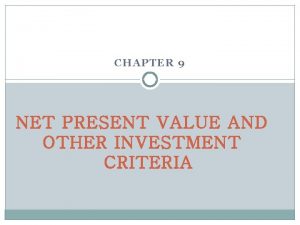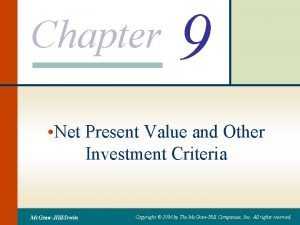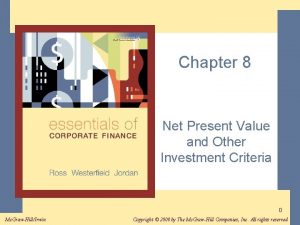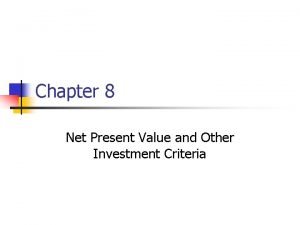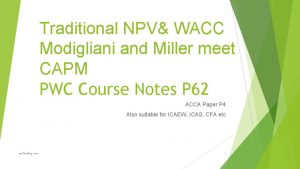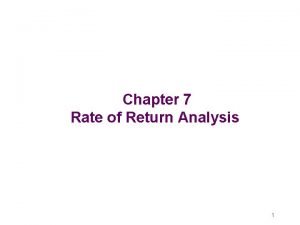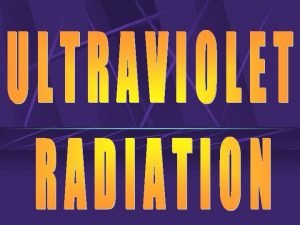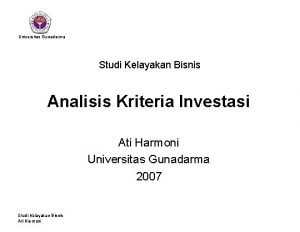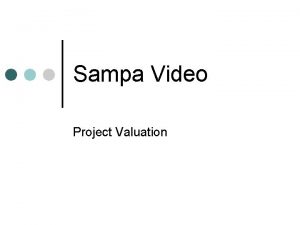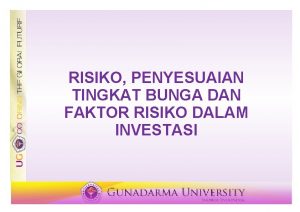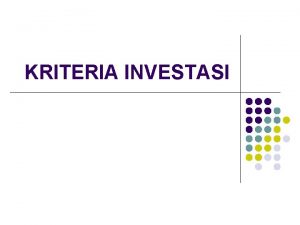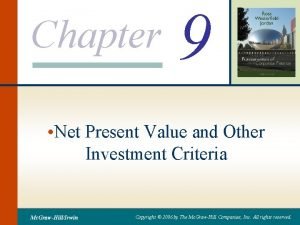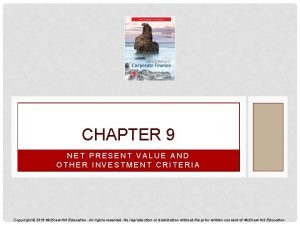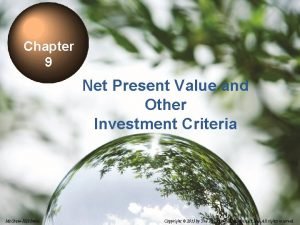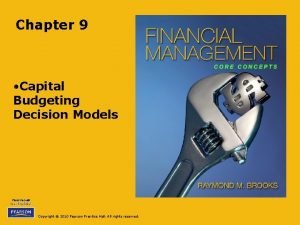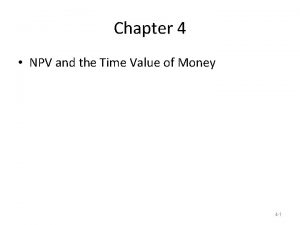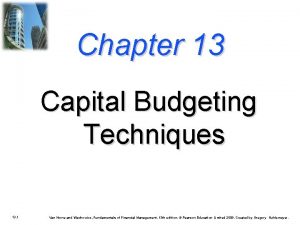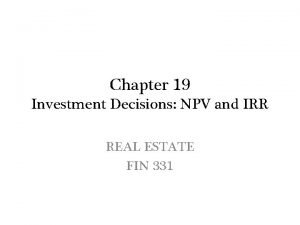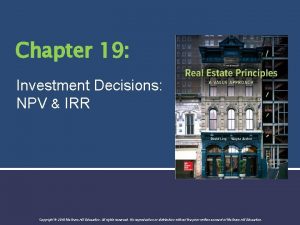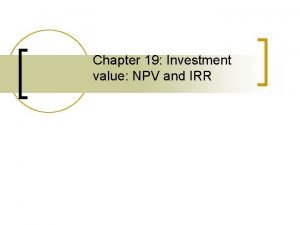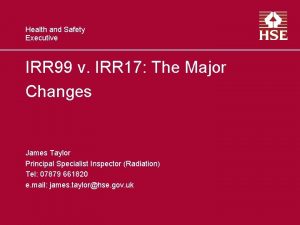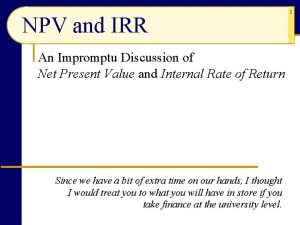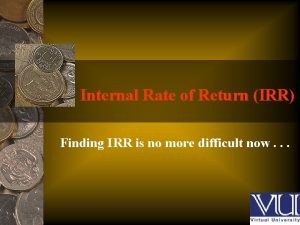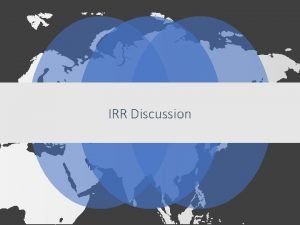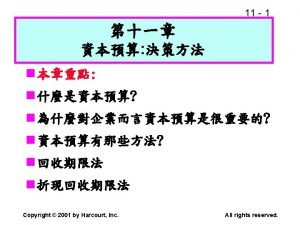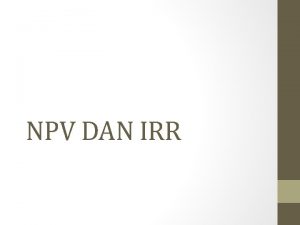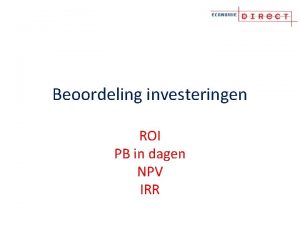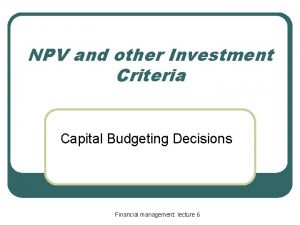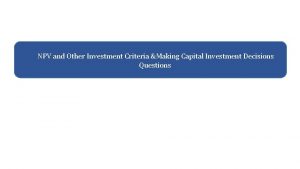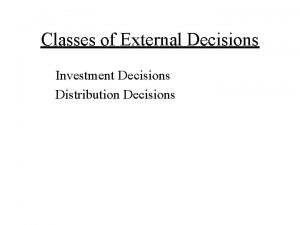Chapter 19 Investment Decisions NPV and IRR Mc
































- Slides: 32

Chapter 19: Investment Decisions: NPV and IRR Mc. Graw-Hill/Irwin Copyright © 2013 by The Mc. Graw-Hill Companies, Inc. All rights reserved.

Overview § Major theme: most RE decisions are made with an investment motive § magnitude of expected CFs--and the values they create—are at the center of investment decision making Chapter 18 focuses on widely used, singleyear, return measures, ratios, & income multipliers § These criteria are relatively easy to calculate & understand—an advantage in the eyes of many industry professionals § 19 -2

Overview § Limitation of these single-year return measures & ratios? § They do not explicitly incorporate income producing ability of property beyond 1 st year of rental operations § May lead to suboptimal investment decisions 19 -3

Overview Many investors also perform multi-year analyses of potential acquisitions § When using multi-year discounted CF decision making methods, investor must § 1. estimate how long she expects to hold property 2. make explicit forecasts of: § § property’s net CF for each year, net CF produced by expected sale of property 3. Select rate of return at which to discount all future CFs 19 -4

Centre Point Office Building 19 -5

Centre Point: 5 -Year Operating Pro Forma-Unlevered 19 -6

Centre Point: Reversion Sale Price 19 -7

Levered vs. Unlevered Cash Flows Levered CFs measure property’s income after subtracting mortgage payments § Valuation of levered CFs? § § Discount expected levered BTCFs rather than the yearly NOIs § Why is owner’s claim on a property’s CFs refereed to as a “residual claim”? 19 -8

Effects of Leverage on Centre Point Cash Inflows & Outflows § Loan Terms § 75% loan, 30 years, 6. 5% annual interest rate, total up-front fees = 3% of loan amount § Net loan proceeds: = $792, 000 − (0. 03 x 792, 000) = $768, 240 § Required equity = $1, 056, 000 - $768, 240 = $287, 760 § Payment: $5, 005. 98 or $60, 072 per year 19 -9

Centre Point 5 -Year Pro Forma with Leverage 19 -10

Present Value of Levered Cash Flows: Centre Point Justification for increasing discount rate from 10. 0% to 14%? 19 -11

Net Present Value of Centre Point NPV = PVin − PVout in this example is equal to original equity investment of $287, 760 NPV = $319, 591 − $287, 760 NPV = $31, 831 Decision: Accept Centre Point investment opportunity because doing so will increase equity investor’s wealth by $31, 831 19 -12

Effect on NPV of Variation in Discount Rate At a discount rate of 16. 8727%, NPV = 0, this is the goingin IRR 19 -13

Centre Point with Mortgage Financing Exhibit 19 -4 $41, 838 Exhibit 19 -5 Yr 6 NOI “capped” at 10%; minus selling costs = $103, 291/0. 10 = $1, 032, 910 rounded to $1, 033, 000, minus $58, 300 in selling expenses 19 -14

Present Value of Levered Cash Flows Justification for increasing discount rate from 11. 75% to 16%? 19 -15

So…From Where Do Discount Rates Come? 19 -16

Selecting Discount Rates § Discount rate is composed of two parts: E(Rj) = r = Rf + RPj § Rf is risk-free rate § yield/return available on U. S. Treasury securities with maturity equal to the expected holding period of the property § This benchmark rate is readily observable § RPj is risk premium for “subject” property § This component of discount rate is difficult to determine 19 -17

U. S. Example: Class A Apartment Properties Source: quarterly survey conducted by Real Estate Research Corporation (www. RERC. com) 19 -18

Selecting Discount Rates § Since risk premiums vary, so do required yields § High quality, relatively safe RE investments: currently 6 -8% required returns § Development: 15%-30% or more § So…how do investors determine required risk premiums (RPjs)? 19 -19

Why IRR Is Technically Inferior to NPV as an Investment Criterion IRR & NPV will always give the same acceptreject signal w. r. t. an individual investment § But…. . § § IRR may rank investment opportunities differently than NPV § NPV ranking is always consistent with wealth maximization § If projected CFs change signs more than once over expected holding period, there may be multiple IRRs 19 -20

Effects of Leverage on NPV & IRR Increased leverage usually increases both NPV and IRR— holding mortgage rate and all other assumptions constant But…leverage also increases risk to equity investor, thus required equity return should increase with leverage 19 -21

When Will Leverage Increase NPV & IRR? § Increased leverage will increase calculated NPV when…. § opportunity cost of equity capital (discount rate) exceeds effective borrowing cost § Increased leverage will increase going-in IRR when…. § unlevered going-in IRR exceeds effective borrowing cost 19 -22

Impact of Leverage on Risk of Equity Investment 19 -23

Income Taxes, Cash Flows & Returns Cash flows and returns most important to investors are after-tax cash flows & returns § The following after-tax analysis assumes a 30 percent income tax rate § More detail on the tax calculations is provided in Chapter 20 § 19 -24

Centre Point: After-Tax Cash Flows 19 -25

How is Required After-Tax Discount Rate Determined? Assume: required before-tax return = 14% Assumed income tax rate on additional income = 30% After-tax required return = 14% − (0. 30 x 14%) = 14% x (1 − 0. 30) = 9. 8% § That is, a reasonable assumption is: after-tax return = before-tax return x (1−TR) § § § where TR is investor’s “marginal” tax rate 19 -26

Centre Point: After-Tax NPV & IRR Note: IRR falls less than 30%: (16. 9 – 12. 8) ÷ 16. 9 = 0. 24 19 -27

Comparison of Three Scenarios Some conclusions: § § Leverage increases expected Centre Point equity returns Taxes significantly reduce net investor CFs and returns 19 -28

More Detailed Cash Flow Projections The pro formas detailed in Exhibits 19 -2 through 19 -12 display major categories of revenues & expenses § However, most RE pro formas provide significantly more detail on projections of § § § revenue sources vacancies operating expenses capital expenditures See Exhibit 19 -14 for an example 19 -29

Varying the Assumptions § Sensitivity analysis § Most likely scenario § Worst-case scenario § Best-case scenario § Value of computer § Excel spreadsheets § Specialized software such as ARGUS § Monte Carlo simulation 19 -30

Nathan Collier on Quantitative Analysis “NPV and IRR are major ways in which investment decisions are evaluated. Each method has its strengths and weaknesses. Proper analysis of investment real estate requires a pro forma, an estimate of income and expenses over a period of time, usually 5 to 10 years. I can create the template for a rough pro forma from scratch in a couple of hours, a complete pro forma with all the bells and whistles and looking crisp could easily take a few days. It is amazing how many people in real estate and finance have never created a pro forma from scratch and couldn’t to save their lives. ” “I’ve told my COO that the requirement to be a financial analyst for The Collier Companies should include the ability to at least create a rough pro forma from scratch solo. Otherwise, how can you truly understand what you are doing? I’m a big “back of the envelope” kind of guy. If the deal is so close that it does not pencil out on a napkin at the table, I’m pretty sure I don’t want to go for it. But before we proceed we double and triple check our gut feel via sifting the deal numbers through a great pro forma. ” Nathan Collier: Chairman, The Collier Companies, a major owner/operator of student apartment communities 19 -31

End of Chapter 19 19 -
 Why do irr and npv rank the two projects differently?
Why do irr and npv rank the two projects differently? Good decision making poster
Good decision making poster Npv a irr wzajemne zależności
Npv a irr wzajemne zależności Npv irr adalah
Npv irr adalah Tax shield formula
Tax shield formula Chapter 10 making capital investment decisions
Chapter 10 making capital investment decisions Screening decisions and preference decisions
Screening decisions and preference decisions Corporate financing and investment decisions
Corporate financing and investment decisions Fixed investment and inventory investment
Fixed investment and inventory investment Making capital investment decisions
Making capital investment decisions Making capital investment decisions
Making capital investment decisions Making capital investment decisions
Making capital investment decisions Net present value discounted cash flow
Net present value discounted cash flow Advantages and disadvantages of payback method
Advantages and disadvantages of payback method Advantage and disadvantage of npv
Advantage and disadvantage of npv Advantage and disadvantage of npv
Advantage and disadvantage of npv 8net
8net Npv and wacc
Npv and wacc Irr and marr
Irr and marr Uvr and irr indications
Uvr and irr indications Tabel npv
Tabel npv Sampa video inc case solution
Sampa video inc case solution Penyesuaian tingkat bunga dengan npv
Penyesuaian tingkat bunga dengan npv Sensitivity specificity ppv npv
Sensitivity specificity ppv npv Npv adalah
Npv adalah Contoh soal investasi dalam aktiva tetap
Contoh soal investasi dalam aktiva tetap What is international capital budgeting
What is international capital budgeting Npv profiles
Npv profiles Npv profiles
Npv profiles Npv profiles
Npv profiles Chapter 9 capital budgeting answer key
Chapter 9 capital budgeting answer key Npv of a perpetuity
Npv of a perpetuity Npv method of project evaluation
Npv method of project evaluation


